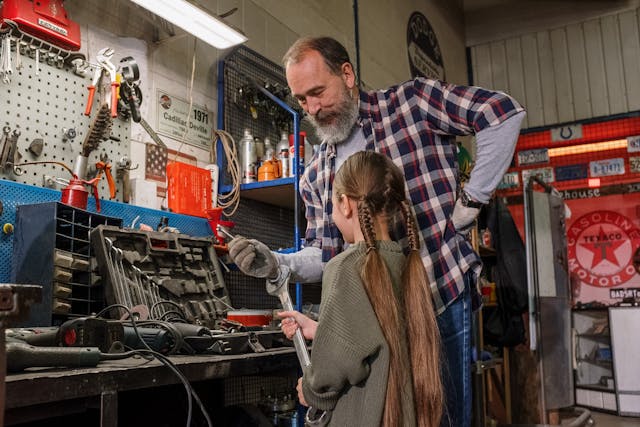Tools & Practices for Adaptive Survival
- Original: 11 Apr. 2025
- Revised: 25 Nov. 2025

Father and Daughter Looking at Tools in a Garage | Free to use under Pexels/Pixabay, Creative Commons Zero (CC0)
This guide outlines essential non-reliance tools and adaptive practices designed to maintain autonomy and capability during periods of systemic disruption, censorship, or infrastructure failure.
1. Offline Maps and Navigation Tools
In a crisis where centralized digital infrastructure is compromised or inaccessible, relying on global, community-driven mapping services is critical. Apps that utilize OpenStreetMap (OSM) data, such as Organic Maps, allow users to download detailed, vector-based maps onto their device while connected. Once downloaded, these maps require no internet or cellular service for navigation, relying solely on your device's built-in GPS receiver.
This capability is vital for mobility, locating resources, and managing logistics when traditional satellite navigation services are unavailable or actively monitored. The underlying data source, OpenStreetMap, is a global, collaborative project that provides a free and open database of the world’s geographical information, often used by humanitarian organizations like the Humanitarian OpenStreetMap Team (HOT) for disaster response.
2. Secure, Decentralized Communication Platforms
Traditional communication systems (SMS, centralized messaging apps, standard email) are highly susceptible to surveillance, throttling, or shutdown. Secure communication in a troubled environment necessitates decentralized, peer-to-peer (P2P) platforms.
Tools like Briar and Jami operate without relying on a central server. Briar, for instance, uses encrypted P2P messaging over alternative networks like Bluetooth or Wi-Fi when the internet is unavailable, ensuring messages are saved only on the participants' devices. This architecture is crucial for maintaining privacy and coordination during internet blackouts or periods of heavy censorship, making it a valuable resource highlighted by digital security groups like the McCain Institute in their resource guides.
3. Local Currency / Barter Network Participation
Economic resilience is achieved by diversifying away from reliance on centralized, national fiat currencies. Local and complementary currency systems are a powerful tool for maintaining economic activity, especially when regional or national financial systems experience instability.
Examples include Local Exchange Trading Systems (LETS) and Time Banks. Time Banks, in particular, promote egalitarian principles where one hour of service, regardless of the skill involved, is equal to one time credit. This fosters social cohesion and mutual aid. Academic studies on community currencies confirm that they provide flexibility and support local enterprise, particularly in times of financial stress or during humanitarian crises. Exploring local initiatives like food co-ops or established Time Banks USA networks is the first step toward building this layer of financial adaptive survival.
4. Print-Ready First Aid and Basic Medical Guides
The ability to provide basic medical care is a non-negotiable survival skill. While digital guides are useful, a hard-copy, print-ready manual is impervious to power outages, water damage, or EMP events.
A comprehensive first aid guide focused on basic trauma, sanitation, and life-support measures (CPR, wound care, hemorrhage control) is essential. Reputable, universally recognized sources like the Canadian Red Cross's Comprehensive Guide for First Aid & CPR or guides from the International Committee of the Red Cross (ICRC) for mass casualty management are ideal, as they reflect global, standardized emergency practices. Printing these guides and protecting them in water-resistant packaging creates an immediate medical resilience asset.
5. Alternative Energy and Off-Grid Power
Energy autonomy dramatically increases survivability and comfort. Grid failure, whether due to natural disaster, conflict, or systemic collapse, should not mean the loss of essential lighting, communication, or medical equipment power.
Focus on portable, low-maintenance solutions such as solar generators (battery systems charged by photovoltaic panels), hand-crank radios, and small wind turbines. While commercial products like Goal Zero are popular, the principle is simple: establishing a tiered system to power critical devices. The shift towards decentralized power, often championed by movements like Solarpunk in communities needing energy independence, highlights the importance of simple, durable energy solutions that bypass complex, vulnerable infrastructure.
6. Water Purification and Storage
Access to safe, potable water is the most critical immediate concern in any disruption. Water purification should involve multiple layers of redundancy.
Beyond simple boiling (which uses fuel), physical filtration and chemical treatment are paramount. Gravity-fed filtration systems (like those using ceramic or carbon block elements) are effective, low-cost, and require zero electricity to remove bacteria and protozoa. Non-commercial, academic research into gravity-fed systems confirms their effectiveness and low operational cost, making them ideal for emergency and off-grid use as discussed by the Pradeep Research Group. Stocking mechanical filters (Katadyn, Sawyer Mini) and chemical treatments (iodine, chlorine dioxide tablets) ensures flexibility across various urban and rural water sources.
7. Low-Tech Information Storage
The greatest vulnerability in a crisis can be the loss of actionable knowledge. Printing vital manuals is one step; storing vast libraries of information on rugged, offline digital mediums is the next.
Consider building or acquiring an Offline Digital Library (ODL). These are typically small, durable, air-gapped devices (often Raspberry Pi-based) that create a local Wi-Fi hotspot broadcasting access to curated digital libraries, such as a static copy of Wikipedia, instructional videos, and academic resources. Organizations like Arizona State University’s SolarSPELL Initiative and other ODL projects focus on providing this "wealth of knowledge without requiring a wealth of investment" to remote communities globally, proving its value as a resilient solution against internet loss or censorship according to the International Journal of Emerging Technologies in Learning.
8. Community Education and Skill-Sharing
Individual preparedness is limited; true resilience is a function of community strength and shared knowledge. Adaptive survival demands a shift from consumer dependency to producer and repairer roles.
Encourage and participate in local knowledge transfer focused on skills like food preservation, gardening, electronics repair, and permaculture design. Permaculture, a design system based on ethical principles (Earth Care, People Care, Fair Share), offers a framework for creating sustainable and self-regulating communities that mimic natural ecosystems. Academic analysis of Permaculture as a global community of practice confirms its utility in redesigning human systems for energy descent and self-sufficiency. Building these localized networks ensures that knowledge—the most valuable survival tool—survives any infrastructure collapse.